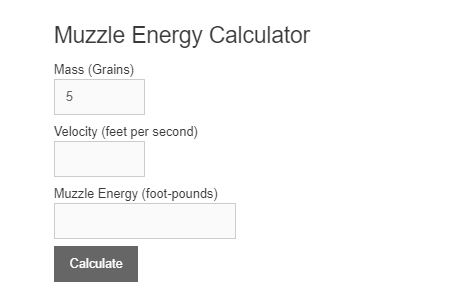Enter the mass of the bullet and the exit velocity to determine the muzzle energy of the gun. This can also be known as a bullet energy calculator. This calculator can also determine either the mass or velocity given the muzzle energy and other value.
- MOA Calculator (minute of angle)
- Coriolis Effect Calculator
- Draw Length Calculator
- FPE Calculator
- Milliradian Calculator
- CUP To PSI Calculator
- Length of Pull Calculator
- Grain To CC Calculator
- Cost Per Round Calculator
- Bullet Force Calculator
Muzzle Energy Formula
The muzzle energy of a gun is determined by the physics equation for kinetic energy which is displayed as follows.
KE = 1/2*m*v^2
- Where KE is kinetic energy
- m is mass
- and v is the velocity
To calculate muzzle energy, multiply the bullet mass by the value of the bullet velocity squared.
For guns, the mass of the bullet is typically measured in grains. One ounce is equal to 437.5 grains. Velocity is usually measured in meters per second or feet per second. For the calculator above, we use grains and feet per second. The resulting muzzle energy unit is foot-pounds. (lbf)
What is bullet energy, and why does it matter?
Bullet energy, also known as muzzle energy, is a measure of the energy a bullet has as it leaves a gun. It’s one of many factors that affect both stopping power and recoil. Stopping power is the ability of a bullet to penetrate material or an object. Higher muzzle energy typically means a higher stopping power, but that’s not the only factor. The aerodynamics of the bullet itself also factor into that stopping power.
The bullet energy also affects the recoil of a gun. In short, this is also governed by one of Newton’s laws of motion. That is that every motion has an equal and opposite motion. This means that the greater the muzzle energy, the greater the recoil. This is an important factor to keep in mind.
Above is a table that outlines a few different size bullets and their corresponding bullet energies, velocity, and masses. You can use the table to check the calculator you are using above. Note the size is denoted by the size in mm.
How to calculate muzzle energy
Let’s take a look at how you might calculate the muzzle energy of an unknown gun and bullet.
- First, we need to weigh the bullet. Most often, this is done using a gram scale. Using the conversion noted above, we find that the weight is equal to 500 grains.
- The next step is to measure the bullet velocity as it leaves the gun. This is typically done using a device similar to a speedometer. Let’s say, for this example, we find the velocity to be 200 ft per second.
- Finally, we need to enter all of the information into the formula above. KE = 500*.5*200^2 = 100,000.
- Last, check the answer with the table above.
